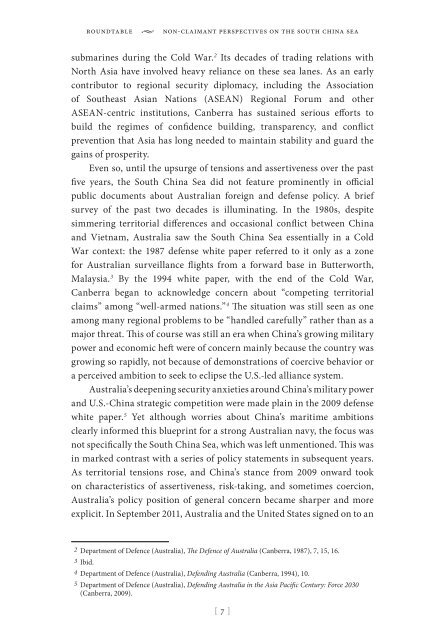Create successful ePaper yourself
Turn your PDF publications into a flip-book with our unique Google optimized e-Paper software.
oundtable • non-claimant perspectives on the south china sea<br />
submarines during the Cold War. 2 Its decades of trading relations with<br />
North Asia have involved heavy reliance on these sea lanes. As an early<br />
contributor to regional security diplomacy, including the Association<br />
of Southeast Asian Nations (ASEAN) Regional Forum and other<br />
ASEAN-centric institutions, Canberra has sustained serious efforts to<br />
build the regimes of confidence building, transparency, and conflict<br />
prevention that Asia has long needed to maintain stability and guard the<br />
gains of prosperity.<br />
Even so, until the upsurge of tensions and assertiveness over the past<br />
five years, the South China Sea did not feature prominently in official<br />
public documents about Australian foreign and defense policy. A brief<br />
survey of the past two decades is illuminating. In the 1980s, despite<br />
simmering territorial differences and occasional conflict between China<br />
and Vietnam, Australia saw the South China Sea essentially in a Cold<br />
War context: the 1987 defense white paper referred to it only as a zone<br />
for Australian surveillance flights from a forward base in Butterworth,<br />
Malaysia. 3 By the 1994 white paper, with the end of the Cold War,<br />
Canberra began to acknowledge concern about “competing territorial<br />
claims” among “well-armed nations.” 4 The situation was still seen as one<br />
among many regional problems to be “handled carefully” rather than as a<br />
major threat. This of course was still an era when China’s growing military<br />
power and economic heft were of concern mainly because the country was<br />
growing so rapidly, not because of demonstrations of coercive behavior or<br />
a perceived ambition to seek to eclipse the U.S.-led alliance system.<br />
Australia’s deepening security anxieties around China’s military power<br />
and U.S.-China strategic competition were made plain in the 2009 defense<br />
white paper. 5 Yet although worries about China’s maritime ambitions<br />
clearly informed this blueprint for a strong Australian navy, the focus was<br />
not specifically the South China Sea, which was left unmentioned. This was<br />
in marked contrast with a series of policy statements in subsequent years.<br />
As territorial tensions rose, and China’s stance from 2009 onward took<br />
on characteristics of assertiveness, risk-taking, and sometimes coercion,<br />
Australia’s policy position of general concern became sharper and more<br />
explicit. In September 2011, Australia and the United States signed on to an<br />
2 Department of Defence (Australia), The Defence of Australia (Canberra, 1987), 7, 15, 16.<br />
3 Ibid.<br />
4 Department of Defence (Australia), Defending Australia (Canberra, 1994), 10.<br />
5 Department of Defence (Australia), Defending Australia in the Asia Pacific Century: Force 2030<br />
(Canberra, 2009).<br />
[ 7 ]


